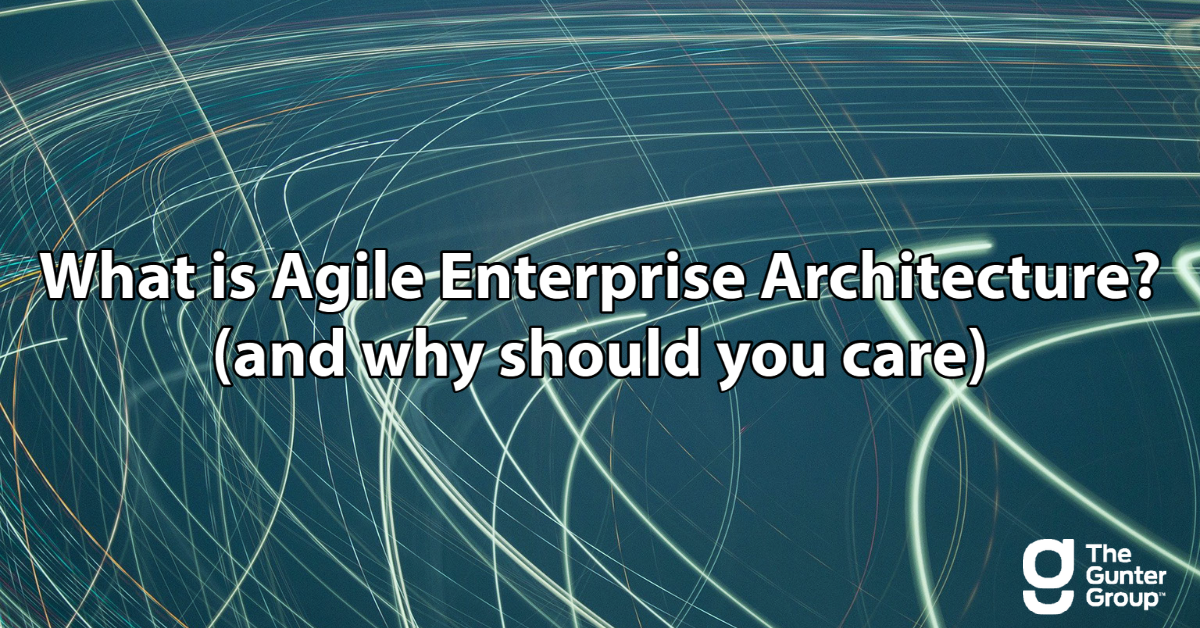In light of the work and results we have delivered to our clients over the past year, today we are introducing a new blog series focused on the impact of successful and strategic Enterprise Architecture.
Being successful in the current business landscape demands agility, a deep focus on customer value, and the ability to build and deliver adaptive strategies.
If you haven’t considered the way these trends are affecting enterprise architecture (EA), you’re already behind.
In this article, we’ll explore a new paradigm: agile enterprise architecture. But before we explain the value of this approach, it’s critical to get on the same page about a few core concepts.
What is enterprise architecture?
Essentially, enterprise architecture is the practice of understanding and documenting components of an enterprise — and the relationships between these components — in order to improve strategic planning and decision making.
The practice of enterprise architecture encompasses discovery (what does the enterprise have now and what will they need in the future?), design (what’s the best way for the enterprise to achieve its goals?), implementation (how do we put this plan into action?), and documentation (how do we synthesize this information in a useful way?).
Enterprise architecture is usually focused on information technology and the relationship between IT and business goals. One major goal of EA is to reduce technology debt, a term used to describe the ongoing costs associated with hastily chosen IT solutions (as opposed to those considered in the context of a long-term plan).
What is agile?
The agile methodology is an approach to the development of products or systems that emphasizes adaptation, evolution, and flexibility.
The first use of the agile methodology was in software development. However, the spirit of agile — as described in The Agile Manifesto — can be applied to many different practice areas, including enterprise architecture. Frameworks like SAFe® provide guidance for applying these principles to different parts of the business.
To boil it down to one key element, an agile approach values responding to change over following a plan, delivering incremental value throughout the entire improvement process. In other words, it is an iterative, ride-along approach rather than a prescriptive, point-in-time approach. Value is created along the journey, instead of being solely located at some distant destination.
The trouble with traditional enterprise architecture
What does EA look like in reality?
Most often, enterprise architecture is the responsibility of one individual or a small team within an organization, or an additional role added to the many on an already overburdened leader. They conduct point-in-time exercises and apply EA “best practices,” which are typically academic in nature rather than drawn from contextualized real-world experience.
The outcome of these exercises is usually a monolithic document that’s difficult to apply to day-to-day decision making. This document purports to “solve” the enterprise’s technology problems, but too often ignores the fact that every solution has a lifecycle, and that the usefulness of solutions changes over time.
Because traditional enterprise architecture plans don’t flex and adapt, the technology solutions proposed by the EA team tend to become disconnected from the strategic pulse of the business. These legacy approaches structurally ignore the fact that what you know now is almost invariably going to be significantly different than what you’ll know later on.
As a result, despite being expected to own the long-term technology strategy for the enterprise, EA teams often slide down the slippery slope towards being perennial meeting floaters, sitting on the sidelines of decisions rather than contributing real value.
What is agile enterprise architecture?
Agile enterprise architecture is a new approach to EA developed by The Gunter Group. Agile EA applies the principles of the agile methodology to enterprise architecture in order to improve business outcomes.
Agile EA focuses on iteration and continuous improvement. In this approach, the job of an enterprise architect is not just to deliver a roadmap — it’s to ride along with the roadmap, continuously closing the gap between the plan and reality as it unfolds.
In addition, a major goal of agile EA is to create a set of architectural patterns that help define business problems and orchestrate their solutions. Agile EA decenters specific technology recommendations in favor of methods and frameworks for finding the right solution in any situation.
To put it another way, an agile enterprise architect understands that “owning” the long-term technology plan for an organization is not a sustainable responsibility. Instead, agile EA focuses on enabling internal teams to generate their own solutions to complex problems in alignment with broader strategic goals.
Agile EA dispenses with outdated and ineffective elements of traditional enterprise architecture practices. Whereas traditional EA is academic, agile EA is pragmatic. Whereas traditional EA is prescriptive, agile EA is adaptive. Whereas traditional EA often becomes decoupled from business strategy, agile EA is solely focused on the ways technology enables business outcomes.
Ultimately, successfully practicing agile enterprise architecture ensures the organization has the technology runway it needs to achieve its strategic goals.
Enterprise architecture as a service (EAaaS)
One manifestation of agile enterprise architecture is enterprise architecture as a service (EAaaS). As opposed to project-based consultants who are rarely around long enough to see the execution of their proposed roadmaps, EAaaS provides ongoing support in a scalable subscription format.
EAaaS can augment or transform in-house EA teams. There are several advantages to this approach, including:
- Knowledge: EAaaS provides access to a broad base of skills that are constantly being honed in real-world environments
- Change: a third-party team can act as a change agent, helping organizations overcome internal roadblocks
- Scalability: EAaaS can be scaled up or down according to current business needs (for example, increasing service following M&A)
- Cost: The Gunter Group’s EAaaS approach will typically cost less than the full-time salaries of an in-house team
Through enterprise architecture as a service, The Gunter Group has the ability to transform an ineffective, impractical enterprise architecture function into an agile driver of positive change.
A new era in enterprise architecture
We believe that agile enterprise architecture — which is best realized through EAaaS — represents a dramatic improvement over the status quo.
More than that, however, we view the shift to this approach as a necessary component of a successful enterprise.
The old models and best practices of enterprise architecture were developed in a different era. They were not built to handle the strain of the rapid growth and change made necessary by the pace of and competition in the modern landscape.
However, by treating your EA capability as a strategic enabler rather than a tactical function, you will unlock business agility, customer value, and long-term success.
Agility is the hallmark of today’s most successful businesses — and you simply cannot have an agile enterprise without agile enterprise architecture.

More about Matt Jamison:
Matt is an experienced solutions architect with a results-oriented understanding of the intersection between reality and architectural theory. He has the ability to plan, develop, and implement large-scale projects while maintaining impeccable attention to detail. With 20 years of functional information technology experience, Matt has end-to-end IT knowledge from layer 1 networking to application API interaction. An expert in mapping technology solutions to business needs, Matt is also able to conform to required regulations while maintaining IT best practices. Matt’s experience spans multiple industries, including healthcare, telecommunications, and security and software. He is an AWS Certified Solutions Architect. Outside of work, Matt enjoys the outdoors and all things bike-related.


